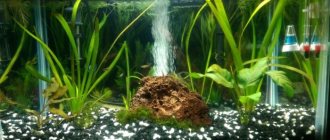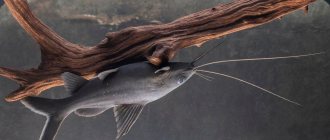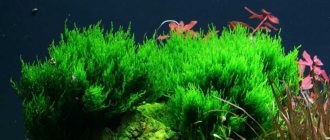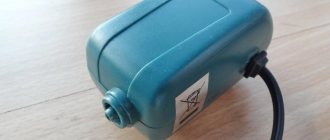Aeration is a special process of saturating water with oxygen molecules. Its essence lies in mixing layers of aquarium water, in which oxygen mixed with air enters through the depth of the water layer. Saturation can occur either from the environment or using a spray. Oxygen can be seen in the water - these are small air bubbles that saturate the aquarium water. When these bubbles come into contact, the water is gradually saturated with oxygen. The number of bubbles directly affects the quality of water saturation. Learn more about what it is aeration in an aquarium, and will be discussed in this article.
Aeration in the aquarium
What is water aeration
Aeration of water in an aquarium is the process of movement of layers of liquid. Aquarium aeration saturates the aquarium water with oxygen. The movement of liquid begins with the release of small water bubbles from the aeration device. The larger the space of the device, the faster the liquid is saturated with gas.
In lakes and rivers, the aeration process occurs due to waves, currents, winds and the abundance of plants. In an aquarium, plants do this, although they are an unreliable supplier of O2, since they consume oxygen when there is a deficiency of carbon dioxide or in the dark.
What happens?
There are 2 types of aquarium aeration:
- natural – the degree of O2 saturation is maintained by flora and fauna of natural origin;
- artificial - O2 supply is carried out by special aerating devices.
The second option is chosen if there is not enough vegetation and the aquarium inhabitants experience hypoxia. This is manifested by the fact that snails crawl from stones onto the glass of the tank or stick to plants, and fish float to the surface and begin to greedily swallow air.
Is aeration necessary in an aquarium?
There are no fish species that do not need oxygen in the aquarium. There are fish that breathe atmospheric air; they float to the top of the water and swallow it. But most inhabitants need O2.
An aquarium is a living world. It is home to not only human-settled pets in the form of fish and other aquatic organisms, but also aerobic bacteria that live in the soil and in plant thickets. These bacteria are not dangerous. They maintain biological balance. In an aquarium without aeration, the balance is disrupted and the inhabitants cannot exist normally.
In still water, the process of penetration of oxygen particles into the water column is very slow. Oxygen particles penetrate only 2 cm into the water per day. For fish in an aquarium, this is very little. Therefore, water must be independently enriched with O2. This is done using filters, compressors, and sprayers.
Is it necessary with plants?
The plants in the aquarium produce enough O2 to support a small number of fish. But for numerous settlements there must be a lot of plants. At night, plants also consume oxygen, leaving living inhabitants without valuable gas. The best solution would be to purchase aerating devices.
Main goals
In addition to the fact that aeration solves the main problem of lack of oxygen, this procedure can also help solve a number of other problems:
- As a result of water circulation, the temperature is equalized throughout the aquarium. And this helps to avoid significant differences.
- This process creates an imitation of natural conditions that some types of fish simply need.
- Aeration also helps get rid of dust and bacterial films that form on the surface over time.
Creating gentle vortex flows helps quickly get rid of carbon dioxide and prevents harmful substances such as methane and hydrogen sulfide from accumulating.
Methods of water aeration
There are two types of water aeration.
Natural
This is growing plants or breeding snails. When plants grow, oxygen is released through photosynthesis.
Snails are an indicator of the amount of gas. When the liquid is depleted of oxygen, they are placed on the leaves of plants or on the walls of the aquarium. If the oxygen level is normal, the snails are placed on the bottom or rocks.
Artificial
This is the use of aeration equipment. Used: compressors and pumps.
Compressor
Compressors spray bubbles into the liquid, which enrich the liquid with O2. They must work in the aquarium continuously.
Is it possible to turn off the compressor?
Aquarium aeration devices must not be switched off. Many new aquarists turn off their water aeration compressors at night because these devices create a lot of noise. This is absolutely impossible to do.
At night, fish especially need aeration, because underwater plants stop releasing O2 and absorb it themselves. Aerating devices must operate continuously and continuously to saturate the water with oxygen.
Sprayers
Air nozzles are part of compressors. With the help of sprayers located in the ground of the aquarium, the air is distributed into bubbles that the compressor pumped from the outside of the aquarium. Air is supplied to the aquarium. Bubbles move layers of water. This helps saturate the liquid with oxygen.
Soil filter
Ground filters for aquariums perform a similar function to a compressor. Filters create currents. This promotes the movement of layers of water. The top layer of water, in contact with air, is saturated with oxygen and sinks to the bottom with the current. When purchasing and installing a ground filter, a compressor is not needed.
Specialized pumps
Water aeration pumps are equipped with a filter device and channels for supplying oxygen to the aquarium. It is purged with air much better than a compressor. The throughput of the pump should be at least one third of the volume of the aquarium.
Hoses and connectors
Hoses and connectors are an additional attribute to the compressor or pump. They are needed to move and rearrange devices. A hose and a sprayer are attached to distribute the bubbles over a larger area throughout the aquarium.
Aeration without electricity
Suitable for transporting fish in the absence of electricity.
Hydrogen peroxide
Hydrogen peroxide is a catalyst that, when released into water, breaks down into oxygen and water. It is completely harmless to underwater inhabitants. Peroxide is used to resuscitate suffocated fish and to destroy harmful algae on plants.
Oxygen tablets
Oxygen tablets are needed to quickly raise the oxygen level in the water. Another purpose is to transport fish in a short time. One oxygen tablet contains 30 mg of oxygen.
How to help a “suffocated” fish?
To revive fish that have suffocated from lack of oxygen, use pharmaceutical hydrogen peroxide 3%.
If the tank volume is no more than 100 liters, you need to add 40 ml of peroxide.
As soon as bubbles appear on the walls, filter and directly on the fish, the water is partially replaced. If no effect is observed after 15 minutes, then it will no longer be possible to save the deceased .
What affects oxygen content
The oxygen content in the aquarium is affected by:
- Temperature. In a liquid with an elevated temperature, the amount of gas is always less than in a liquid with a lower temperature. Elevated temperature is dangerous by accelerating metabolism. With accelerated metabolism, aquatic organisms consume O2 more than usual at the moment when its deficiency is observed.
- Flora of the aquarium. Plants emit O2 in the light, but at night they also consume it.
- Bacteria. Aerobic bacteria living in the soil are beneficial for the microflora of the aquarium. But when there is leftover food or a large amount of waste, the bacteria are activated and actively multiply. A large number of aerobic bacteria will only cause harm, because it will cause a lack of O2.
DIY aeration
Pet stores sell a variety of devices that can purify the air. But there is an option to do aeration in the aquarium with your own hands.
To make a compressor for an aquarium with your own hands, you will have to purchase a power supply and a motor.
What you will need:
- Power unit.
- A small motor (for example, from a printer).
- Plastic cover.
- Candles.
- Rubber tube.
- Adapter.
- Balloon.
- A wooden stick (for example, from a lollipop).
- Hot glue stick.
- Several wooden blocks.
- Plywood.
- Wire.
- An elastic band (for example, from a bicycle inner tube or a ball).
How to make a compressor for aeration with your own hands:
- Cut the balloon in half with scissors.
- Take a plastic cover and drill 2 holes in it (3 and 6 mm) at the same distance. Sand rough edges.
- We cut out a horseshoe shape from elastic band. This will be the valve of the device. The valve is glued with its legs to the inside of the drilled cover. The wide part of the valve should cover the 3mm hole.
- We pull the cut out part of the ball onto the lid. The surface should be elastic, like a small drum. Glue with tape and trim off the excess parts of the ball.
- Cut out a small rectangle from plywood. It must be proportionate to the motor. Glue the motor to the plywood.
- Now let's make the base of the compressor. We take a piece of plywood and 2 bars. We glue the bars to the plywood in the form of legs and supports. We glue the prepared motor with plywood into the corner. At the bottom there is a connector for connecting the power supply.
- We shorten the stick; it should be no more than 8 mm wide. Using an awl, we pierce holes on the top and sides. Insert a piece of wire into the hole on the side. It turned out to be an eccentric. We install it on the motor shaft.
- Shorten the lollipop stick by 4 cm. Glue it to the candlestick. To attach it to the eccentric, drill a hole on the side of the stick and attach it. Attach the other end of the stick with glue to the center of the lid with the ball. Glue the cover onto the plywood.
- Cut a 6 mm hole in the lid with the ball. Fix the adapter into the hole and attach the rubber tube.
Errors
- O2 does not enter the liquid from bubbles produced by the compressor. Oxygen is above the water, on the surface. In still water, gas saturation is weak. The formation of bubbles leads to the movement of water, the formation of water currents and good gas exchange of the liquid.
- As the temperature rises, you need to saturate the water more with gases or always maintain a constant water temperature.
- Many aquarists do not test for O2 levels in their water.
- It is important to equip tanks for raising fry with aerating devices. In these aquariums, oxygen is consumed by a large number of individuals under cramped conditions.
Aeration maintains stable gas exchange of water and destroys films on the surface of the liquid. Therefore, a tank equipped with an aeration system will be a reliable and safe home for underwater inhabitants.
Previous
AquariumChoosing a quiet, silent compressor for your aquarium
Next
AquariumStep-by-step instructions for sealing an aquarium when a leak is detected











